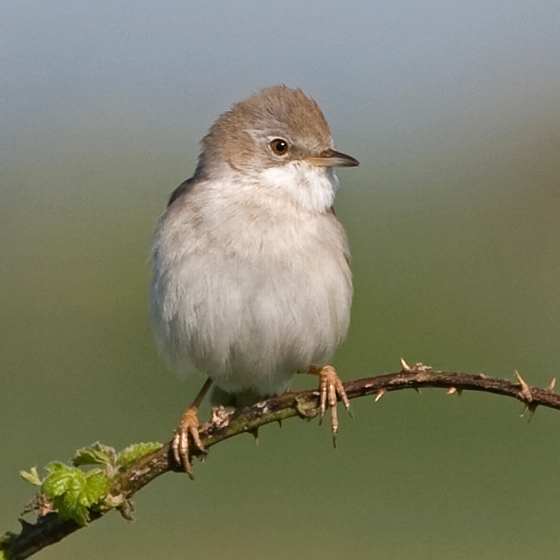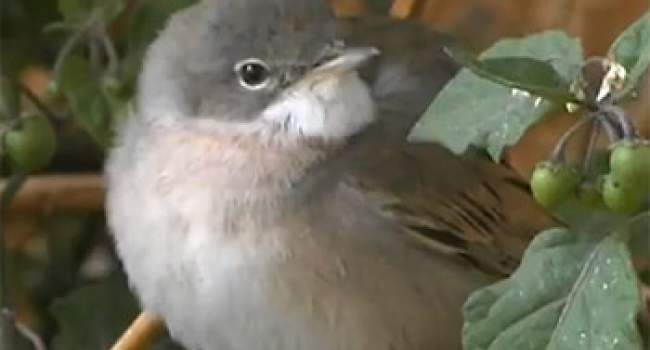Whitethroat
Curruca communis (Latham, 1787)
WH
 WHITE
WHITE  12750
12750

Family: Passeriformes > Sylviidae

A summer visitor from Africa, this small, brown warbler frequents hedgerow and scrubby areas across Britain & Ireland from April to October.
Its winter quarters in Africa occupy the dry Sahel just to the south of the Sahara. This area is subject to prolonged periods of drought which affect Whitethroat overwinter survival. Such conditions led to a crash of 90% in UK Whitethroat numbers in the late-1960s, from which this species is still recovering.
Whitethroats breed throughout the UK and it can be found from Cornwall to northern Scotland, as well as across Ireland. The species is only absent from our mountain tops.
Exploring the trends for Whitethroat
Our Trends Explorer will also give you the latest insight into how the UK's Whitethroat population is changing.
trends explorerIdentification
Whitethroat identification is often straightforward. The following article may help when identifying Whitethroat.
SONGS AND CALLS
Listen to example recordings of the main vocalisations of Whitethroat, provided by xeno-canto contributors.
Call
Song
Develop your bird ID skills with our training courses
Our interactive online courses are a great way to develop your bird identification skills, whether you're new to the hobby or a competent birder looking to hone your abilities.
Browse training coursesStatus and Trends
Population size and trends and patterns of distribution based on BTO surveys and atlases with data collected by BTO volunteers.
CONSERVATION STATUS
This species can be found on the following statutory and conservation listings and schedules.
POPULATION CHANGE
Whitethroat numbers had been stable for a few years up to 1968 but, despite a normal departure for their West African wintering grounds in autumn 1968, crashed by around 70% between the 1968 and 1969 breeding seasons (Winstanley et al. 1974). They fluctuated around their lower level until the mid 1980s, since when the population has sustained a consistent shallow recovery. Recovery of the UK population has been most apparent along linear waterways. The BBS map of change in relative density between 1994-96 and 2007-09 indicates that increase over that period was strong in Scotland and parts of northern and southern England, contrasting with a decrease in parts of East Anglia. More recent BBS data show that, since 1995, a rapid increase has occurred in Scotland and a shallow increase in England, but this contrasts with a moderate decline in Wales over the same period. There has been an increase across Europe since 1980 (PECBMS: PECBMS 2020a>). After a spell on the UK amber list during 2009-15, warranted by the limited extent of its UK recovery, further population increase has returned Whitethroat to the green list at the latest review (Eaton et al. 2015).
| UK breeding population |
-63% decrease (1967–2020) 
|
Exploring the trends for Whitethroat
Our Trends Explorer will also give you the latest insight into how the UK's Whitethroat population is changing.
trends explorerDISTRIBUTION
Whitethroats are distributed throughout Britain and Ireland with the exception of higher uplands, particularly of northern England and Scotland. They are scarce in the Outer Hebrides, the Northern Isles and southwest Ireland. Densities are low in Ireland, highest in the lowlands of southern, central and eastern England.
Occupied 10-km squares in UK
| No. occupied in breeding season | 2492 |
| % occupied in breeding season | 83 |
| No. occupied in winter | 5 |
| % occupied in winter | 0.2 |
European Distribution Map
Relative frequency by habitat
Relative occurrence in different habitat types during the breeding season.

DISTRIBUTION CHANGE
Whitethroat numbers have changed considerably, linked with changing rainfall patterns in their African wintering grounds. Corresponding changes in range size are less apparent, although there has been an increase in density between c.1990 and c.2010.
Change in occupied 10-km squares in the UK
| % change in range in breeding season (1968–72 to 2008–11) | +0.1% |
| % change in range in winter (1981–84 to 2007–11) | --57.1% |
SEASONALITY
Whitethroat is a summer visitor, arriving in mid April with most birds departed by the end of September.

Movement
Information about movement and migration based on online bird portals (e.g. BirdTrack), Ringing schemes and tracking studies.
An overview of year-round movements for the whole of Europe can be seen on the EuroBirdPortal viewer.
RINGING RECOVERIES
View a summary of recoveries in the Online Ringing Report.
Foreign locations of birds ringed or recovered in Britain & Ireland

Biology
Lifecycle and body size information about Whitethroat, including statistics on nesting, eggs and lifespan based on BTO ringing and nest recording data.
PRODUCTIVITY & NESTING
Exploring the trends for Whitethroat
Our Trends Explorer will also give you the latest insight into how the UK's Whitethroat population is changing.
trends explorerSURVIVAL & LONGEVITY
View number ringed each year in the Online Ringing Report
Maximum Age from Ringing 
|
7 years 9 months 5 days (set in 2011) 
|
Typical Lifespan 
|
2 years with breeding typically at 1 year |
Adult Survival 
|
0.391±0.025  
|
Juvenile Survival 
|
0.289 (in first year) 
|
Exploring the trends for Whitethroat
Our Trends Explorer will also give you the latest insight into how the UK's Whitethroat population is changing.
trends explorerBIOMETRICS
Wing Length 
|
Adults | 70.8±1.9 | Range 68–74mm, N=11983 |
| Juveniles | 70.9±1.8 | Range 68-74mm, N=13133 | |
| Males | 71.4±1.9 | Range 68–74mm, N=4594 | |
| Females | 70.1±1.8 | Range 67–73mm, N=3933 |
Body Weight 
|
Adults | 13.8±1.34 | Range 12.0–16.4g, N=10699 |
| Juveniles | 14.6±1.9982 | Range 12.6–17.6g, N=11566 | |
| Males | 13.3±1.07 | Range 12.0–15.2g, N=3998 | |
| Females | 14.2±1.43 | Range 12.2–16.8g, N=3428 |
Feather measurements and photos on featherbase 
CODES & CLASSIFICATION
Ring size 
|
A |
Field Codes 
|
2-letter: WH | 5-letter code: WHITE | Euring: 12750 |
For information in another language (where available) click on a linked name
Research
Interpretation and scientific publications about Whitethroat from BTO scientists.
CAUSES AND SOLUTIONS
Causes of change
There is good evidence that the major changes in the population of this species have been driven by conditions on its wintering grounds and so are related to overwinter survival.
Further information on causes of change
In a pioneering study, Winstanley et al. (1974) provided good evidence to link the 1969 crash to drought in the Whitethroat's wintering grounds in the western Sahel, just south of the Sahara Desert. More recent analysis of data from four western European countries found a strong relationship between overwinter survival and population change over a 20-year period (Johnston et al. 2016). Correspondingly, Baillie & Peach (1992) found that breeding performance was poorly correlated with population changes. They found that fluctuations in losses of adult birds were correlated with conditions on the wintering grounds, and were correlated with Sahel rainfall. Thus, the population appears to be limited by food resources on the wintering grounds, because rainfall in the dry Sahelian landscape promotes greater invertebrate abundance. There has been no long-term trend in the number of fledglings per breeding attempt (see above). Productivity, as measured by CES, rose during the 1980s and has since fluctuated and fallen back.
More recent work has provided good evidence that the density of Whitethroats wintering in the Sahel is correlated with the number and size of trees, and that the increase in overall density of trees was related to an increase in Whitethroats in the area (Stevens et al. 2010). Wilson & Cresswell (2006) found that Whitethroats were most common in areas with intermediate tree heights. They suggest that Whitethroats appear to be able to survive in extremely degraded habitats, yet may be vulnerable to the disappearance of Salvadora trees, the fruit of which assists pre-migratory fattening. This is likely to be a separate mechanism to the earlier rainfall mechanism contributing to the population decline and is probably linked to the more recent gradual increase.
Information about conservation actions
The 1969 crash was caused by problems in the wintering area and research suggests that recent changes may also be linked to the availability of food resources in winter (see Causes of Change section, above). It is unclear, therefore, how much impact conservation actions during the breeding season will have on the population trends, if any. However, ensuring that good quality breeding habitat is available will help to ensure that breeding productivity remains high and that numbers have the potential to increase during good wintering years.
A study in Leicestershire found that providing low hedges and uncut 2 m buffer strips of perennial herbaceous vegetation alongside these hedges would benefit Whitethroats on farmland (Stoate & Szczur 2001). A Polish study looking at linear habitats found that Whitethroat preferred habitat with structural heterogeneity and was attracted by brambles and nettles (Szymanski & Antczak 2013). As well as management of hedges and adjacent vegetation, other actions to provide suitable areas of mixed scrub may also benefit Whitethroat, including long-term set-aside and provision of exclosures to prevent deer browsing and exclude livestock.
Links to more information from ConservationEvidence.com
Would you like to search for another species?













Share this page